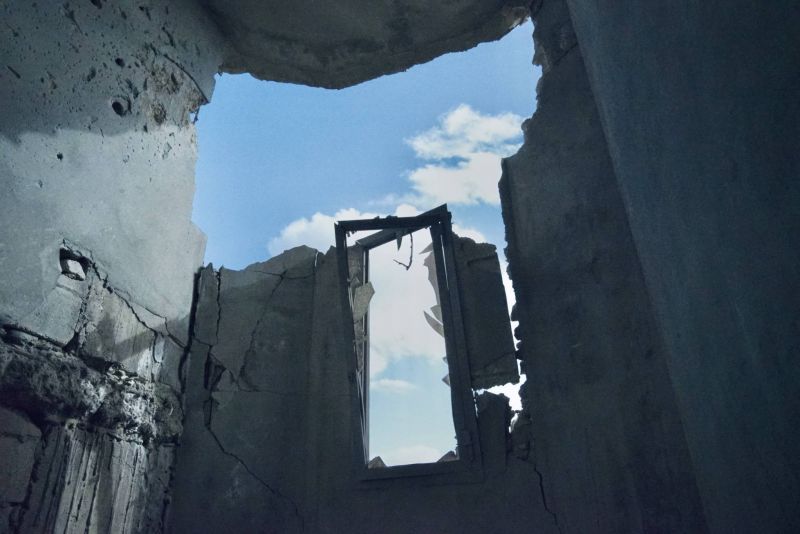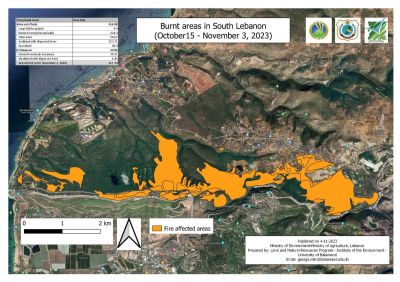
A wall that was struck by an Israeli shell in Aita al-Shaab, Nov. 27, 2023 (Credit: Olivia Le Poidevin)
At 12:30 p.m. on Monday, Dec. 18, in Aita al-Shaab's public square in southern Lebanon, a rocket landed mere meters from the funeral procession of Hassan Srour, a local resident who was killed the previous day while attempting to rescue villagers injured by an Israeli strike. Thankfully, there were no casualties from the funeral attack, but this did not quell the anger among villagers or those in the neighboring towns of Yaroun and Mais al-Jabal, which have been primary targets for the Israeli military since hostilities began on Oct. 8, following the Hamas-launched Operation al-Aqsa Flood the previous day.
Why are these villages under relentless attack?
“Finding themselves on the demarcation lines of the southern border, Aita al-Shaab, Yaroun and Mais al-Jabal are considered military regions,” says a source close to Hezbollah, who agreed to speak to L’Orient Today on the condition of anonymity.
“These areas in question are situated less than three kilometers from the border, and therefore within the five-kilometer perimeter defined by the rules of engagements,” explained Gen. Amine Hoteit, a former army officer and military strategist who is close to Hezbollah. “They are situated in front [of] Israeli military posts,” he added, highlighting that "they are part of a delimited zone, defined by geopolitics, including 14 villages between Naqoura and Mtolleh.
“Geopolitics has imposed on the current war a regulated [or limited] form [of combat], unlike the open war of 2006," the retired military general said. Speaking more explicitly, he said: “In the actual conflict, the objectives, zones and means of combat are well defined, as opposed to a war in which it is allowed to target any location and use any arms for the destruction of the adversary.”
Hoteit indicated that in the ongoing clashes, the Israeli army specifically targets the points from which Hezbollah launches its attacks.
Hezbollah cells?
In the presence of such strict rules, why are civilians and regions far from the border being hit? “Like all rules, the rules of engagement have exceptions,” says Hoteit, who believes that “these don’t exceed 20 percent" of targets reached by Israel.
An observer interviewed by L’Orient Today thinks, for their part, that “certain residences have been targeted because they are home to Hezbollah cells.” He also speculated that “the bombardments of houses could be based on false intelligence, giving the belief that they house members of such cells.”
In Mais al-Jabal, the president of the municipal council, Abdel Menhem Choucair, confirmed to our newspaper that “one month ago, a civilian was killed while they were in their home.”
“Since the start of the war, many people have been injured, and around 20 lodgings have been damaged,” he said, adding that “they were all inhabited.”
'We are confronted by a ferocious enemy'Choucair attributes the continued attacks against his village to the fact that it is situated across from Manara, a kibbutz in northern Israel. “At the slightest friction, we are exposed to some bombardments."
A resident of Yaroun, another border village that was recently hit by Israeli strikes, said, “We are confronted by a ferocious enemy,” and described considerable damage caused by bombardments “in private buildings, but also in the mosque and church of the village.”
For a member of the municipal council of Aita al-Shaab, who spoke to L'Orient Today on the condition of anonymity, “the attacks by Israel are sometimes targeted, sometimes indiscriminate.”
The council member also described losing whole forested areas to fires ignited by Isreali strikes. From the start of the conflict, Israeli military drones have repeatedly dropped white phosphorus ammunition on forests and green areas in the south, claiming they were acting as "protection" for Hezbollah fighters.
“A third of houses in Aita al-Shaab have also suffered damage,” prompting "an exodus of hundreds of families to safer regions."
"During the 2006 war, the inhabitants who had fled their homes were able to return after an agreement to cease hostilities, while in the current conflict, no cease-fire has yet been concluded," said the Aita al-Shaab council member, calling on "the free, civilized world, which prides itself on defending human rights," to intervene to end the war.
